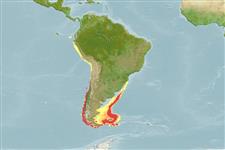Common names from other countries
Classification / Names / Names
Common names | Synonyms | Catalog of Fishes (gen., sp.) | ITIS | CoL | WoRMS
Environment: milieu / climate zone / depth range / distribution range
Ecology
Demersal; depth range 82 - 1679 m (Ref. 93324). Temperate
Southeast Pacific and Southwest Atlantic.
Length at first maturity / Size / Weight / Age
Maturity: Lm ? range ? - ? cm
Life cycle and mating behavior
Maturity | Reproduction | Spawning | Eggs | Fecundity | Larvae
Members of the order Cumacea are gonochoric and sexually dimorphic. Spawning is characterized by nocturnal swarming behavior. Females brood the eggs in the marsupium where they molt, become mancas and leave.
Watling, L. 2005. (Ref. 8293)
IUCN Red List Status (Ref. 130435)
CITES status (Ref. 108899)
Not Evaluated
Not Evaluated
Human uses
| FishSource |
Tools
More information
Age/Size
Growth
Length-weight
Length-length
Morphology
Larvae
Abundance
Internet sources
Estimates based on models
Preferred temperature
(Ref.
115969): 2.9 - 6.2, mean 4.3 (based on 91 cells).
